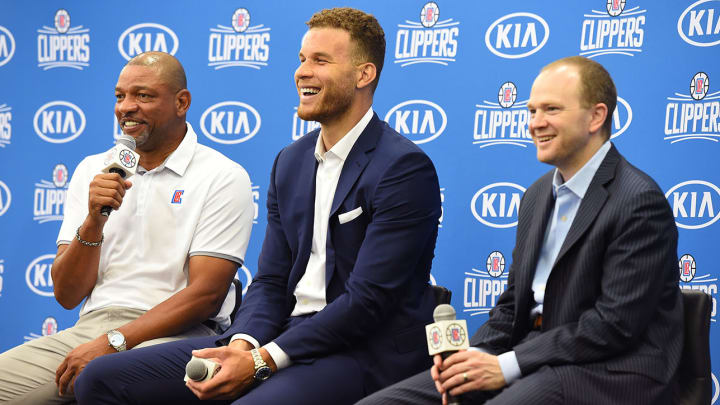Blake Griffin and the Max Contract Conundrum

The natural first reaction to the Blake Griffin trade was confusion, skepticism, and double-checking to make sure that Woj account was real. But within a few minutes it all made sense. Clippers management had decided it didn't make sense to pay $173 million to a power forward who would spend the next few years headlining, in the very best case scenario, a sixth place team in the West. The Pistons, a franchise that opened a new downtown arena this year only to receive a tepid reception locally, decided that a genuine superstar and realistic shot at sixth place in the East sounded just fine. Ultimately the trade led to broad praise of Jerry West's foresight and gentle worries about the expensive mediocrity that seems likely for Detroit.
As the week unfolds, the subtext to everyone's Clippers optimism and Pistons skepticism is becoming clear: Blake Griffin is making too much money. The thinking is that if a team is paying Griffin $30 million to be its best player, there's a ceiling on how much sustainable success that team can have. Whether that's actually true remains to be seen, but looking at the Clippers after four months, the theory looks plausible.
Clippers’ Doc Rivers: ‘Out of Nowhere’ Blake Griffin Blockbuster Had its Roots in Playoff Collapses
Griffin was coming off his eighth season as a pro this past summer, and that made him eligible to sign a max contract worth 30% of the salary cap. Initially there were questions about whether the Clippers would commit that much money to him, and he was planning on meeting with both the Suns and Nuggets at the outset of free agency. Both Denver and Phoenix—like Detroit—likely would have been star-thirsty enough to give him whatever he wanted. But on the heels of trading Chris Paul, the Clippers couldn't afford to lose their second superstar for nothing, so they had no choice but to offer a five-year, $173 million deal. Only L.A. could offer that extra fifth year of security—Griffin will make $38.9 million in 2021–2022 should he exercise that season's player option—and once that offer was on the table, Blake's decision was easy.
It made sense for the Clippers to pay whatever they could to keep Griffin rather than losing him for nothing, and it made sense for Griffin to maximize his money and security to stay. The problem is that in a basketball context, the logic of that contract begins to fray. Blake Griffin is still very good, but he's not dominant enough to give you production that's worth 30% percent of the salary cap, especially as annual raises kick in and his game declines as he gets older. And that's where the story begins to go beyond Blake.
In reality, there are only 15 or 20 players around the league who can earn that much money (30% of the team's salary cap, with 5-8% raises each season) and give their team proportional production on the court. When you include max contracts for players with 10 years of service or "supermax" deals that take the same terms—35% of the salary cap with the same 5-8% annual raises—the pack of players who can make that investment worthwhile gets even thinner. Russell Westbrook might be able to make it work in OKC and Steph Curry will be worth it to the Warriors, but will John Wall ever be able to give Washington $40 million worth of basketball value? Even among players who aren't on the supermax level: Is Paul Millsap worth $30 million-a-year in Denver? In 2019, when the Raptors are paying Kyle Lowry $34 million, will he be giving them proportional production on the court? Is Gordon Hayward ($30 million) going to return next year and give the Celtics six times the production they're getting from Jaylen Brown ($5.1 million)?
All of the stars in that paragraph are excellent, but at some point the numbers are so large that it becomes difficult to build a team around them. With players who are older and/or injury prone like Blake, the calculus gets even trickier. And yet, this is what the market dictates for stars.

In theory, the current salary structure of the NBA makes sense. The latest CBA raised the minimum salaries for the bottom of the league, while making it easier to reward the superstars who are actually selling the league and generating interest. If stars are paid beyond what they can produce in a basketball context, it makes sense—stars create intangible brand value and enhance the long-term value of the franchises themselves. The best players should be rewarded in kind. The problem is that if the current system is designed to make the bottom of rosters more expensive while also rewarding superstars, that model only works for teams if they can show restraint and creativity when it's time to spend on the NBA's middle class.
In some places, that's exactly what's happening. Boston turned over half its team over the summer and became far more top-heavy with Al Horford, Kyrie Irving, and Gordon Hayward all playing on max deals. The rest of the roster is full of players on rookie deals and cheap signings in free agency and there is basically no middle class in Boston. And because Boston scouts so well and Brad Stevens is a genius, the Celtics have made this model successful. It doesn't matter that Hayward's not even playing, or Horford is making $4 million more than Anthony Davis. The bottom half of their roster solves these inefficiencies when guys like Jaylen Brown, Jayson Tatum, and Marcus Smart out-perform their contracts.
A similar story is happening in Toronto, where Masai Ujiri has extended the Raptors window by foisting failed signings onto bad teams (DeMarre Carroll) and replenishing the bench with fantastic young players who out-perform cheap deals. That dynamic helps soften the blow of massive deals for DeMar DeRozan, Kyle Lowry, and Serge Ibaka. The Spurs, of course, invented this artform, optimizing cheap talent off the bench to maintain balance as costs rise at the top of the roster. The Rockets, too, have mastered this dark art in recent years, with Daryl Morey using a combination of shrewd draft picks (Clint Capela) and discounted veterans (PJ Tucker, Nene) to build around his stars.
Superstars are a prerequisite to relevance in today's NBA, but more and more it looks like the prerequisite to actually succeeding with superstars is spending wisely everywhere else. The Warriors exemplify this in their own right, as they fill out their roster with shrewd draft picks (Jordan Bell) and cheap reclamation projects (Nick Young). Although, in fairness, they have an additional advantage because their most expensive talent produces more efficiently than anyone in the sport.
In any case, next to those handful of success stories in the new landscape, there are cautionary tales all over the league. The Blazers could waste the entirety of Damian Lillard's prime because of regrettable contracts handed out to players like Evan Turner, Mo Harkless, and Meyers Leonard. The Wizards have to rely on veterans like Mike Scott and Jodie Meeks to out-perform cheap contracts because they invested too much money in failed signings like Ian Mahinmi and Jason Smith. Minnesota owes $64 million to Gorgui Dieng through 2021, not to mention a five-year, $148 million commitment to Andrew Wiggins that will make things more complicated when it's time to pay Karl Towns or Jimmy Butler. The Grizzlies could have survived the Mike Conley contract but they won't survive the Chandler Parsons contract. The Pelicans have been doomed by bad investments in the likes of Omer Asik and Solomon Hill, and they could have one of the highest payrolls in basketball if they pay DeMarcus Cousins this summer. You could tell similar stories about complicated cap sheets in Denver, OKC, Milwaukee, and on and on around the league. And then there are the Pistons and Clippers.
Lights Dim on Lob City as Clippers Acknowledge Harsh Reality
Detroit is paying Andre Drummond like a superstar, and they'd also committed big money to middle-class players like Reggie Jackson, Tobias Harris, and Avery Bradley, none of whom were moving the needle for a ninth-place team that can't afford to be irrelevant. The Clippers spent big on Blake Griffin and were faced with the prospect of paying DeAndre Jordan this summer, while also paying significant money to Danillo Gallinari and Austin Rivers—all for a team that's currently fighting for an eighth seed.
The lessons of what went wrong in L.A. and Detroit are colored by the specific contexts in each case, but the broader story is simple: it's become incredibly difficult to build a contender in the NBA. Contracts have been inflated for players in every tier of the league and stars have the leverage to command more money than ever, but the cap has stopped rising. It's made the current environment more unforgiving than ever. Teams need to find themselves in position to pay the right stars, which requires a lot of luck, and once they pay them, they need to be incredibly smart everywhere else on the roster.
More often than not, walking that tightrope ends in failure. Teams are left to choose between embracing marginal success with an increasingly expensive roster, or blowing up their nucleus to try building smarter and luckier the next time. There are merits to either approach, but the debate itself isn’t the point. What's important is that this week’s Blake Griffin trade just gave us both sides of a dilemma that quietly dominates the entire league.
